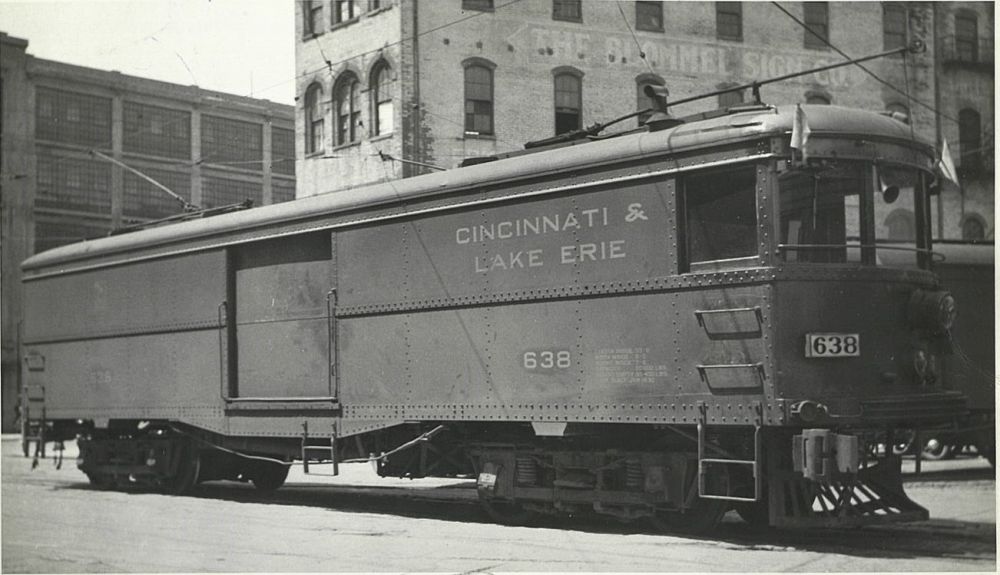
Sister car 635 Builders hoto – STM Curatorial file
- Builder
- Cincinnati Car Co.
- Description
- Freight motor
- Secondary Use
- None
- Type
- Locomotives, RPOs, Baggage and Express
- Year
- 1930
- Retired from Service
- 1976
- Acquired by the Museum
- 1976
- Fund
- 608
- Sponsor/Manager
- None
Cincinnati & Lake Erie Railroad 648
From Ohio
History
The Cincinnati & Lake Erie Railroad was formed in 1930 through a merger of three smaller interurbans to form a through line between Cincinnati and Toledo, Ohio, with a connection via the Eastern Michigan Railway to Detroit. A branch served Columbus, OH. The C&LE, led by Thomas Conway, undertook improvements to compete more effectively with the highways and steam railroads. Conway’s most prominent move was acquiring 20 new, high-speed, lightweight passenger cars in 1930 for the 285 mile trip between Cincinnati and Detroit. One of these “Red Devils,” No. 118, later went to the Cedar Rapids & Iowa City Ry. and is now at Seashore. Also in 1930, Cincinnati Car Co. built 15 freight motors (Nos. 635 – 649) for the Cincinnati & Lake Erie. This fleet was designed for fast express and less-than-carload freight service. For these vehicles, Cincinnati Car used some parts salvaged from older interurban passenger cars. No. 648 included parts from Ohio Electric Railway cars built in 1911. The freight motors were powered through trolley poles and were equipped with controls for a motorman. Aside from the motorman’s cab, the interior was an empty space for freight which could be loaded through large, sliding doors in the center of each side, similar to a railroad box car. The C&LE typically used a single freight motor to pull several freight cars but could also couple more than one freight motor in MU operation.
When the C&LE ended service in 1939, all 15 of the 1930 freight motors were acquired by other operators. Nos. 641 and 648 went to the Tulsa-Sapulpa Union Traction Co. The Tulsa-Sapulpa renumbered No. 648 to No. 202. No. 641 became No. 203 at the T-SU. During World War II, T-SU painted No. 202 to publicize war bonds. The TSU operated the two former C&LE freight motors until 1955 when it purchased two second-hand Westinghouse electric locomotives. The T-SU sold the Nos. 202 and 203 to Leonard Nolen, a salvage operator at Sand Springs, OK, when then sold them to Borg Compressed Metal Corporation in Tulsa. No. 203 was eventually scrapped. The T-SU dieselized in 1959.
Seashore purchased T-SU No. 202 from Borg Compressed Metal in 1974, but did not move it to Kennebunkport until 1976. It was stored outside.
In 1995 No. 648 was moved into the shop and restoration work begun. Sheathing, which had been covered with chicken wire to prevent it from blowing away during the car’s trip east, was replaced. The roof was removed and the roof ribs, top sills and exterior letterboard were cleaned of rust and painted. Sheets of OSB were used to cover the roof skeleton. Milled tongue and groove for the roof was purchased and then stored in the car. No. 648 was then tarped and stored outside.
Work started again in 2008, concentrating on the metal work from the front end back to the large side doors. Rivets holding the frame channels and angles together were cut out. Steel plates were purchased to replace badly deteriorated sections. A search was begun to find a sandblasting company capable of handling the large project.
Technical Information
- Control: Westinghouse HL-169
- Brakes: AMU
- Compressor: D4
Trucks
- Number: 2
- Manufacturer: Taylor
- Model: MCB
Motor
- Number: 4
- Manufacturer: Westinghouse
- Model: 303A
Weight and Dimensions
- Length: 50’
- Width: 8’ 8.00"
- Height: 13’ 5.00"
- Weight: 85300 lbs.
Additional Images

Sister car 638 in service – STM Curatorial file
© 1998 - 2025 New England Electric Railway Historical Society. All Rights Reserved.